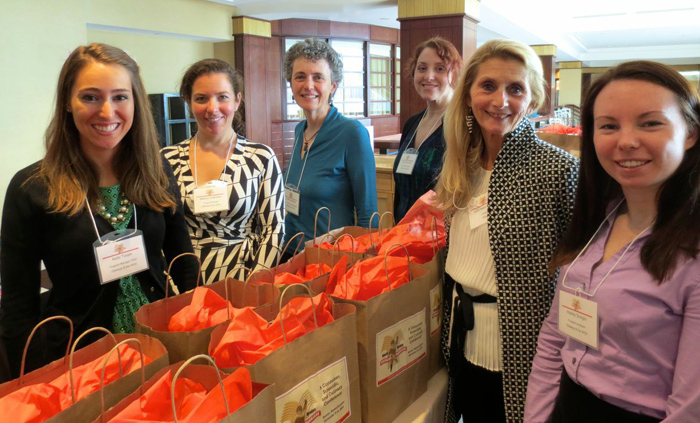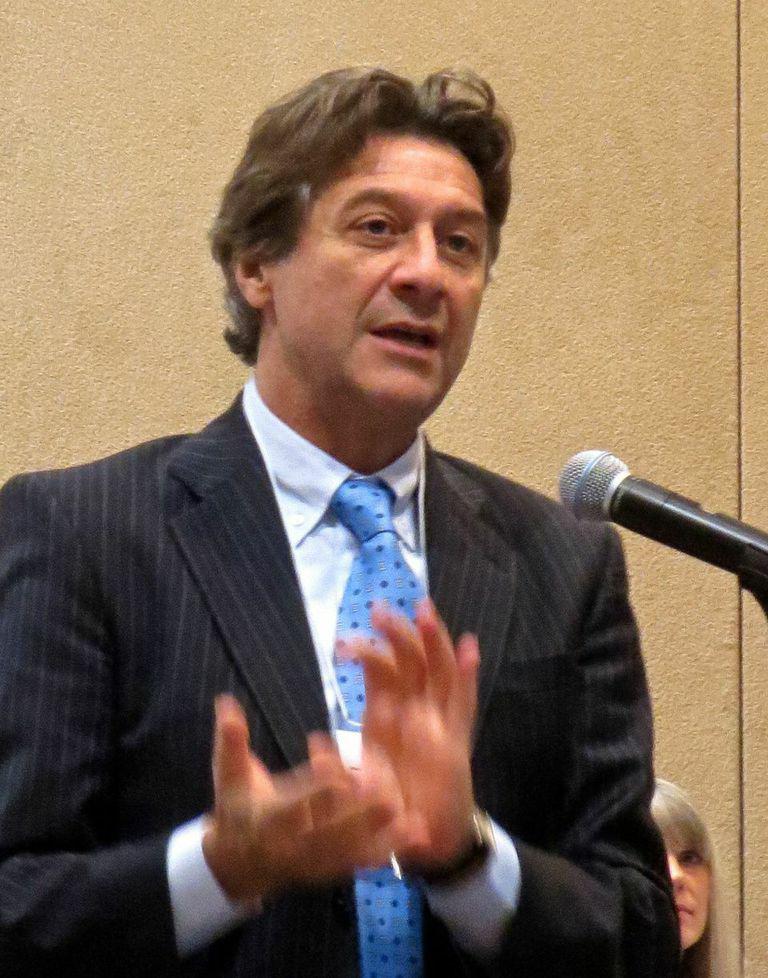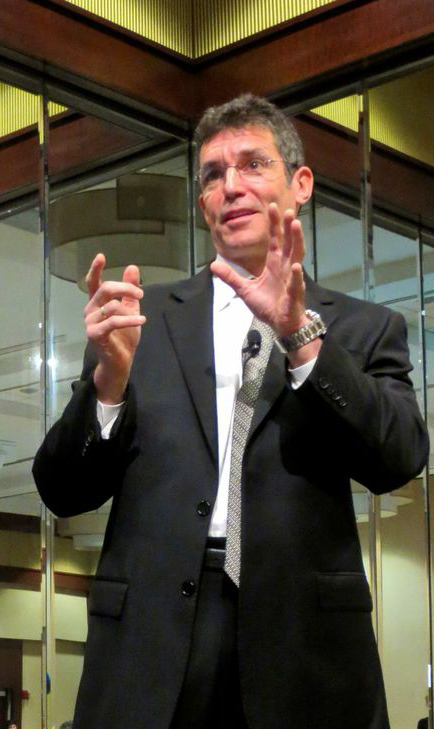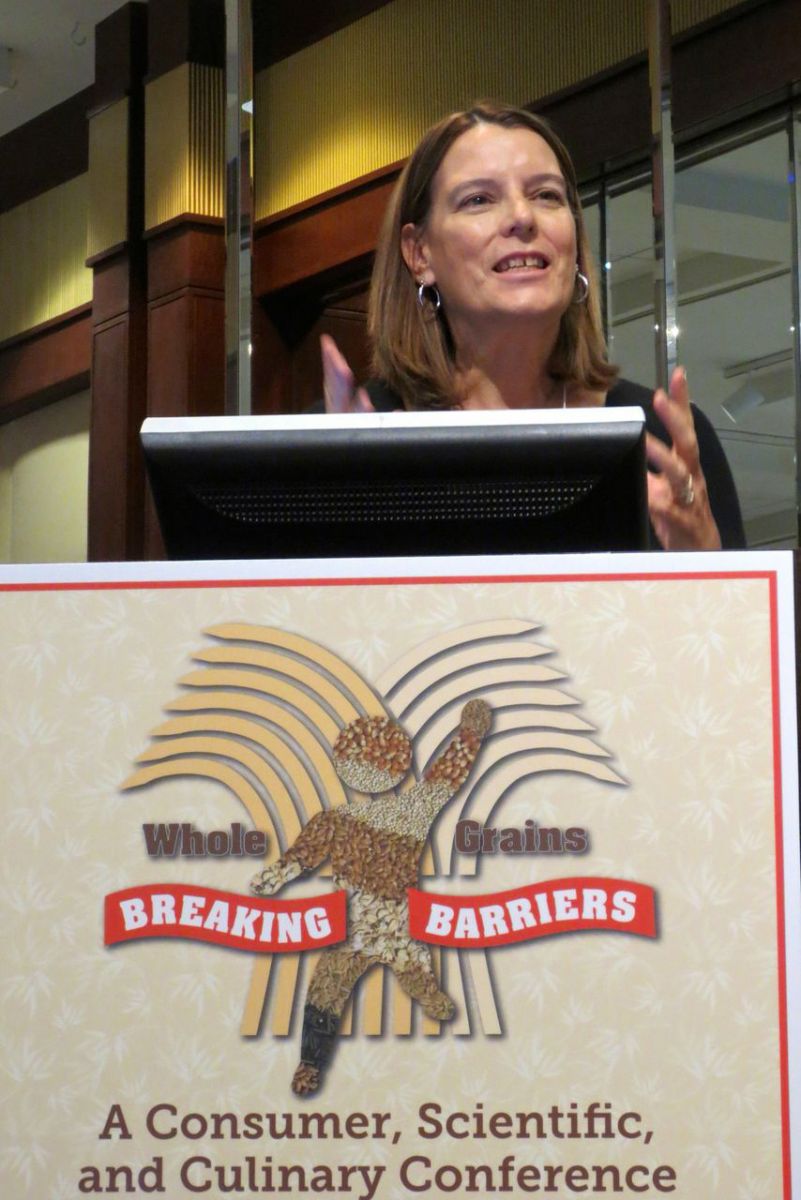Share This
L to R: Kelly Toups, Mallory Cushman, Cynthia Harriman, Rachel Greenstein, Sara Baer-Sinnott and Harley Songin
Oldways and the Whole Grains Council just threw a giant three-day party for 200 people in our hometown of Boston – the Whole Grains: Breaking Barriers conference. We’re exhausted and exhilarated, and soooo glad we were able to get some important messages in front of our international attendees and the more than two dozen journalists who joined us. In today’s blog, we’ll share some of the key take-aways from this event.
We don’t all need to go gluten-free – or grain-free. Our keynote speaker, Dr. Alessio Fasano, world-renowned expert on celiac disease and gluten and Director of the Celiac Research Center at MassGeneral Hospital for Children, answered the key question of the conference – Should everyone avoid gluten? – with a resounding no.
Dr. Fasano’s presentation put the rise In celiac disease into context, pointing out that many other autoimmune diseases – unrelated to gluten — have been rising at similar rates in recent decades. Based on current research, he suggests that changes in our microbiome – the balance of “good” and “bad” bacteria in our guts – are likely at the root of the increase in celiac and other autoimmune diseases. “Nutrition is the key element, the most influential component, in microbiome composition,” he concluded, implying that an overall poor diet could make all of us susceptible to such diseases. “No question there is a fad component” to the gluten-free trend, he stated. “We are not born with the destiny to develop celiac disease
Dr. David Katz, Director of Yale’s Prevention Research Center, picked up that theme, declaring, “DNA is not destiny – dinner is destiny.” Dr. Katz, whose presentation was titled “What did Paleo man really eat?” said upfront that he “didn’t come to throw the Paleo diet under the bus” because there are many laudable aspects of the Paleo diet concept – such as eating whole, unprocessed foods. According to Dr. Katz, however, few people pick up on that core concept, instead using the popular fad diet as a rationale for “eating whatever the hell they want.” He pointed out, “Folks, there was no Paleolithic pastrami!”
According to Dr. Katz, many paleo-anthropologists believe that the Paleo diet was primarily plant-based anyhow, providing as much as 100g of fiber daily. He decried our society’s tendency to ignore established nutritional science, while constantly looking for some new magic-bullet answer and fretting about macro- and micro-nutrients. “Our problem is not what we don’t know; it’s that we don’t use what we know. … Get the foods right and the nutrients take care of themselves – and getting it right includes whole grains.”
Pam Cureton, RD, Clinical/Research Dietitian for the Celiac Research Center, is an expert on the pros and cons of gluten-free and grain-free diets. She advised conference attendees that gluten-free diets are a life-saver for people diagnosed with celiac disease – but she cautioned others against self-diagnosing a gluten problem and starting a gluten-free diet with medical advice. “If you take away just one point from my talk,” she asserted, “It’s this: never start a gluten-free diet before proper testing is completed.” Once someone is no longer ingesting gluten, testing will be inconclusive.
Cureton warned that gluten-free diets tend to be low in fiber, iron, B vitamins, calcium and several other nutrients, while generally being higher in calories, fat and sugar, often resulting in poor bone health, constipation and weight gain. She advised anyone with a medical reason for following a gluten-free diet to seek out the many gluten free grains – “These grains are little nutritional powerhouses!” – and skip the gluten-free brownies and cookies.
Whole grains have great taste and momentum (and oh yeah, they’re healthy). Among people not taken in by pseudoscience and fad diets, whole grains are going gang-busters. A few snapshots from the conference:
- June Jo Lee, VP of Strategic Insights for the Hartman Group, cited “fresh, whole and real” as key food trends, adding that “whole grains are right at the center of that.”
- Three award-winning Boston chefs —- Ana Sortun of Oleana, Jason Bond of Bondir and Barry Maiden of Hungry Mother — accompanied by the farmer — Liz L’Etoile of Four Star Farms — who grows many of their grains, spoke passionately about some of the whole grain dishes that are flying off their menus.
- Chef and baking expert Peter Reinhart (below) explained the benefits of sprouted whole grains, and wowed us with the delicious taste of his sprouted whole wheat bread and sprouted cornbread (which he baked in the hotel kitchen early that morning!)
- Two local public school food directors, Samantha Weiss Kimball, MPH, RD from Boston and Mellissa Honeywood, RD from Cambridge, explained how the new school food requirements for whole grain foods have been smoothly implemented at their schools. “We are trying to broaden the taste experience of these kids so they can grow into healthy adults,” said Ms. Honeywood. All her schools have gardens and some of the schools are even growing their own whole grains!
- On our manufacturers’ panel, Anna Rosales, RD, Nutrition Director Region America for Barilla, stated that her company had started out making its whole grain pasta with 51% whole grain, but was now transitioning to a whole grain pasta that is 100% whole grain – with pasta sales holding steady or increasing, now that more and more people are on the whole grain bandwagon.
- Even convenience stores are getting a makeover. Jim Bressi, Director of Product Development for Kwik Trip, says his chain of 425 stores in the Midwest has its own bakery, where it produces whole grain breads qualifying for the Whole Grain Stamp that it sells for just 99¢ a loaf. Healthy breads and fresh fruit are becoming hallmarks of the chain, inspiring other c-stores.
Although Dr. Furio Brighenti and Dr. Nicola McKeown detailed the health benefits of whole grains in detail, everyone – from chefs, to doctors and dietitians, to manufacturers and retailers – agreed that using the “h” word tends to scare people off. Simply make whole grains delicious, with honest ingredients, sell them at an affordable price, and the fact that they’re healthy is just a hidden bonus, a whispered aside to mention while people are tucking into their favorite whole grain foods!
But wait, there’s more! We can’t recap every speaker in one blog. A few additional highlights were Dr. Marco Gobbetti (whose work we blogged about recently) explained how a mix of specific traditional sourdough cultures can render wheat technically gluten-free; Dr. James Hamblin alerted us to the “recipe” for successful pseudoscience; and Dr. Brett Carver detailed how today’s wheat is largely unchanged from the wheat of a century – or a millennium – ago and is not GMO or higher in gluten.
You can check out the full list of speakers and download presentations from most of them on the Whole Grains Council’s website. By early December we’ll be posting video of most of our speakers’ presentations so you, too, can hang on their every word, as we did last week in Boston!
— Cynthia






Add a Comment